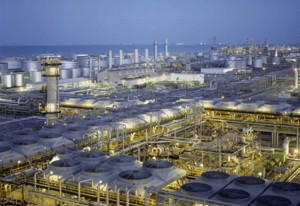Seeking higher revenues, Saudi sets out stall for light crude
DUBAI (Reuters) -- Despite OPEC's oil output curbs, Saudi Arabia has been offering its customers more light crudes while cutting heavy grades, a trend that could increase as the kingdom wants to maximize revenue and needs more heavy oil to power its own refineries.
This trend, if sustained, will impact refining margins particularly in Asia, and narrow the spread between light and heavy crude globally, industry sources and analysts said.
That would be bad news for sophisticated refiners, which value heavy grades because the lower cost of such oil results in higher margins, and good news for older, simpler plants that generally need light, sweet crude.
Saudi Arabia cut the April prices of light crude it sells to Asia for the first time in three months in an effort to shore up demand. The spread between Arab Light and Heavy was at $2.45 a barrel, the narrowest since September.
Before the OPEC output pact, in mid-November 2016, Brent futures for delivery in June 2017 were trading at a premium of around $4 per barrel over Oman futures. That has since narrowed to around $1.25.
The Organization of the Petroleum Exporting Countries, Russia and a number of other producers pledged to cut output by about 1.8 MMbpd from Jan. 1, the first curb in eight years, to boost prices and erode a glut.
OPEC is discussing whether to extend the pact beyond June.
Saudi Arabia, the world's top oil exporter, accounts for some 40% of the pledged OPEC curbs and has reduced output by more than 500,000 bpd to slightly below 10 MMbpd, with cuts concentrated mainly in medium and heavy grades.
Those cuts, and increasing output of US shale oil, have increased the price of Middle Eastern heavy crudes for Asian delivery, making it economical for traders to ship crude from Russia, the Atlantic Basin and the United States to Asia.
Most of the heavier Saudi grades comes from offshore fields -- mainly Safaniya, Manifa and Zuluf, which makes production costly compared to other Middle Eastern producers such as Iran and Iraq, industry sources said.
"You have to meet local demand first, and domestic refineries in Saudi Arabia need the heavy grades," one industry source said.
"To sell the heavy grades at a competitive price against other producers, you would be producing at higher cost but selling at low profit."
Saudi Arabia produces a range of crudes ranging from Arab Extra Light to Arab Heavy. It has nine refineries with processing capacity of about 2.9 MMbpd, of which just above 1 MMbpd of refining power runs on medium and heavy grades.
"Strategically, if they have to cut back a little they would prefer to cut back the expensive offshore production and sustain the lighter crudes," said Sadad al-Husseini, an energy consultant and former senior executive at state oil giant Saudi Aramco.
Light, sweet crudes are more valuable to refiners because they are easier to process, while heavier and sour grades often trade at a discount.
SUMMER SAPS SAUDI SHIPMENTS
Saudi Arabia burns more crude in summer for power generation, on average using 700,000 bpd for electricity to keep the population cool in the hottest months from May to August.
It is set to burn less crude this summer as the kingdom raises energy prices and uses more natural gas in power stations, industry sources said, but higher domestic demand for oil should still weigh on exports.
While exports of lighter grades to Europe should rise in the summer to meet higher demand for transportation fuels, demand for heavier grades in Saudi Arabia is not expected to change much, industry sources say.
"If Saudi Arabia keeps production at 10 MMbpd through summer, domestic crude burning will be less -- but it will remain. That would mean fewer exports," another industry source said.
Husseini said Saudi Arabia would probably burn condensate, light crudes or even diesel for electricity generation rather than medium or heavy crude, which can damage power plants.
In general, lower exports of medium and heavy crudes can be attributed to either less production of those grades or more domestic demand, Saudi-based industry sources said.
The sources said one reason for exporting more light oil in recent months was also related to a shortage of heavier crudes in Saudi Arabia.
"Saudi deliberately cut its crude production in 1999, 2002 and 2009. In each of these three episodes, the share of light crude production has increased at the expense of medium grade output," analysts at Bank of America Merrill Lynch wrote in a note in January.
"The historical pattern to sell more profitable (light) grades should be no different or even more pronounced this time around as the kingdom needs to maximize its revenues in this low price environment."
The price discount of Arab Heavy to Arab Light has narrowed in the past few weeks and this trend should persist for the next few months at least, the bank's analysts said.
Reporting by Rania El Gamal; Editing by Dale Hudson







Comments